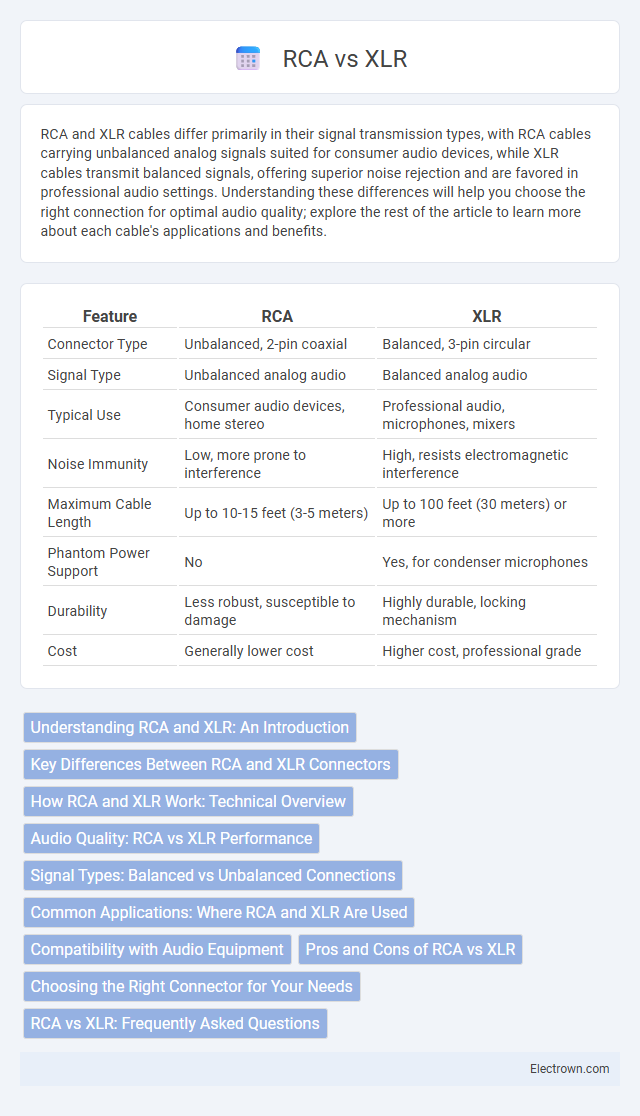RCA and XLR cables differ primarily in their signal transmission types, with RCA cables carrying unbalanced analog signals suited for consumer audio devices, while XLR cables transmit balanced signals, offering superior noise rejection and are favored in professional audio settings. Understanding these differences will help you choose the right connection for optimal audio quality; explore the rest of the article to learn more about each cable's applications and benefits.
Table of Comparison
| Feature | RCA | XLR |
|---|---|---|
| Connector Type | Unbalanced, 2-pin coaxial | Balanced, 3-pin circular |
| Signal Type | Unbalanced analog audio | Balanced analog audio |
| Typical Use | Consumer audio devices, home stereo | Professional audio, microphones, mixers |
| Noise Immunity | Low, more prone to interference | High, resists electromagnetic interference |
| Maximum Cable Length | Up to 10-15 feet (3-5 meters) | Up to 100 feet (30 meters) or more |
| Phantom Power Support | No | Yes, for condenser microphones |
| Durability | Less robust, susceptible to damage | Highly durable, locking mechanism |
| Cost | Generally lower cost | Higher cost, professional grade |
Understanding RCA and XLR: An Introduction
RCA and XLR connectors serve distinct roles in audio equipment, with RCA primarily used for consumer electronics and unbalanced signals, while XLR is preferred for professional audio applications due to its balanced connection that reduces noise interference. Understanding these differences helps you choose the right cable for optimal sound quality and signal integrity in your setup. XLR connectors typically offer greater durability and secure locking mechanisms, making them ideal for live sound and studio environments.
Key Differences Between RCA and XLR Connectors
RCA connectors are unbalanced, typically used for consumer audio equipment and carry signal as a single conductor with a ground, which can result in more noise interference over longer distances. XLR connectors are balanced, commonly found in professional audio settings, using three pins to carry positive, negative, and ground signals, providing better noise rejection and higher audio fidelity. You should choose XLR for longer cable runs or studio-quality sound, while RCA suits shorter connections and consumer electronics.
How RCA and XLR Work: Technical Overview
RCA connectors utilize an unbalanced signal transfer method, where the signal is carried through a single conductor with a separate ground, making them susceptible to noise and interference over longer cable runs. XLR connectors employ a balanced signal transmission using three pins: one for ground and two for carrying the audio signal in opposite polarities, which cancels out noise and ensures a cleaner, more reliable audio output. The differential signaling in XLR cables provides superior noise rejection, making them ideal for professional audio environments compared to the typically consumer-grade RCA connectors.
Audio Quality: RCA vs XLR Performance
XLR cables generally provide superior audio quality over RCA cables due to their balanced design, which effectively reduces electromagnetic interference and noise, ensuring a cleaner signal transfer. RCA cables transmit unbalanced signals, making them more susceptible to noise and signal degradation, especially over longer cable runs. Consequently, professional audio systems and high-end recording environments prefer XLR connections for their consistent and high-fidelity audio performance.
Signal Types: Balanced vs Unbalanced Connections
XLR connectors support balanced audio signals, using three pins to carry positive, negative, and ground signals, which significantly reduces noise and interference over long cable runs. RCA connectors carry unbalanced signals with two conductors, making them more susceptible to electromagnetic interference and signal degradation, especially in longer cables. Balanced connections via XLR are preferred in professional audio setups for maintaining signal integrity and minimizing noise.
Common Applications: Where RCA and XLR Are Used
RCA connectors are commonly used in consumer audio devices such as home theater systems, DVD players, and stereo receivers due to their simplicity and affordability. XLR connectors dominate professional audio environments, including live sound reinforcement, recording studios, and broadcast applications, because they provide balanced connections that minimize noise and signal interference. The choice between RCA and XLR depends on the requirement for signal quality, with RCA suited for unbalanced, short-distance transfers and XLR favored for balanced, long-distance audio transmission.
Compatibility with Audio Equipment
RCA connectors are widely compatible with consumer audio equipment such as home stereos, TVs, and DVD players, making them suitable for unbalanced audio signals. XLR connectors are predominantly used in professional audio gear like microphones, mixers, and studio monitors due to their balanced connection that reduces noise and interference. Understanding the compatibility of RCA versus XLR is crucial for selecting the appropriate cable type in both home and professional audio setups.
Pros and Cons of RCA vs XLR
RCA connectors offer a cost-effective, easy-to-use solution for consumer audio with wide compatibility but lack balanced audio transmission, making them prone to noise and interference over long cable runs. XLR connectors provide superior audio quality through balanced signals, reducing noise and delivering professional-grade sound, though they come at a higher price and may require specialized equipment. Choosing RCA is ideal for short, casual setups, while XLR is preferred in professional audio contexts demanding cleaner, more reliable connections.
Choosing the Right Connector for Your Needs
Choosing the right connector depends on your audio setup and performance requirements. RCA connectors are ideal for consumer-grade equipment and unbalanced audio signals, providing simplicity and affordability. XLR connectors deliver balanced audio, superior noise rejection, and are preferred in professional environments for microphones and high-quality audio interfaces, ensuring Your signal integrity over longer cable runs.
RCA vs XLR: Frequently Asked Questions
RCA and XLR connectors serve different purposes in audio setups, with RCA typically used for consumer-grade stereo systems and XLR favored in professional audio for balanced connections that reduce noise. You should choose XLR cables for longer runs and environments requiring high signal integrity, while RCA works well for shorter, unbalanced connections. Common questions often address compatibility, sound quality differences, and cable length limitations between these two connector types.
rca vs xlr Infographic

 electrown.com
electrown.com